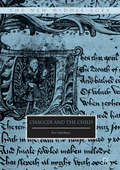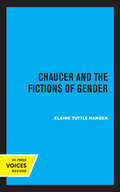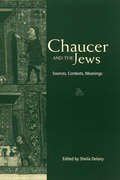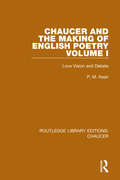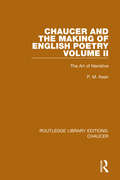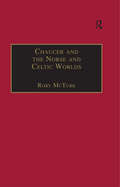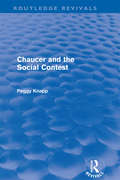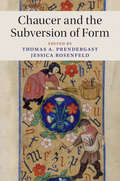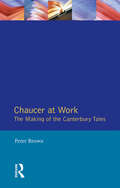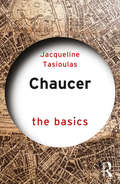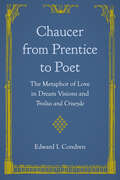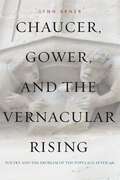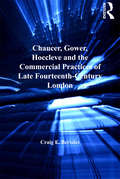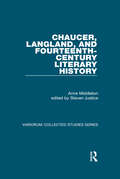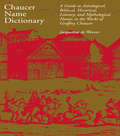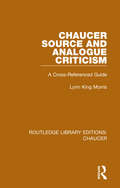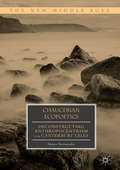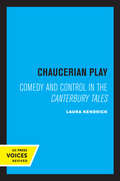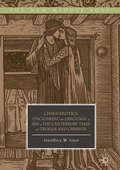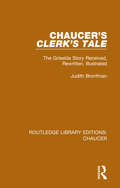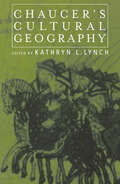- Table View
- List View
Chaucer and the Child (The New Middle Ages)
by Eve SalisburyThis book addresses portrayals of children in a wide array of Chaucerian works. Situated within a larger discourse on childhood, Ages of Man theories, and debates about the status of the child in the late fourteenth century, Chaucer's literary children--from infant to adolescent--offer a means by which to hear the voices of youth not prominently treated in social history. The readings in this study urge our attention to literary children, encouraging us to think more thoroughly about the Chaucerian collection from their perspectives. Eve Salisbury argues that the child is neither missing in the late Middle Ages nor in Chaucer's work, but is,rather, fundamental to the institutions of the time and central to the poet's concerns.
Chaucer and the Fictions of Gender
by Elaine Tuttle HansenThis title is part of UC Press's Voices Revived program, which commemorates University of California Press’s mission to seek out and cultivate the brightest minds and give them voice, reach, and impact. Drawing on a backlist dating to 1893, Voices Revived makes high-quality, peer-reviewed scholarship accessible once again using print-on-demand technology. This title was originally published in 1992.
Chaucer and the Jews (Multicultural Middle Ages Ser.)
by Sheila DelanyThis edited collection explores the importance of the Jews in the English Christian imagination of the 14th and 15th centuries - long after their expulsion from Britain in 1290.
Chaucer and the Legend of Good Women: A Medieval Murder Mystery
by Philippa MorganThree years after his secret mission to Aquitaine, the poet and diplomat Geoffrey Chaucer finds himself once more embarked on royal business. After an arduous journey in the spring of 1373, he reaches Florence, a city twice the size of London and the banking center of Europe. Chaucer has come for money for Edward III, who needs a loan to prop up the ongoing English campaign against France. Arrangements have been made with the banking house run by Antonio Lipari. It should be a straightforward exchange, but Chaucer soon discovers that various people are opposed to the deal, including Lipari's blind brother and his ambitious secretary. Within days Antonio Lipari has died in suspicious circumstances. Violence is bubbling under the surface of this city of stone towers and golden vistas. Outside the walls is camped a band of English mercenaries while, inside, Chaucer himself is aware of shadowy pursuers. Following a trail of fish and the clues provided by a fallen statue, Chaucer must establish the truth about Lipari¹s death and others before he can return home to England. Meanwhile back in London, Chaucer's wife suspects a plot against her sister Katherine--one of the most powerful women in England.
Chaucer and the Making of English Poetry, Volume 1: Love Vision and Debate (Routledge Library Editions: Chaucer)
by P. M. KeanOriginally published in 1972. This important work of Chaucerian scholarship deals with two aspects of the poet and his work - his individual achievement and his place in history - and demonstrates that in both these senses Chaucer is a maker of English poetry. The author assesses the extent of Chaucer’s debt to the English tradition. She considers the development of his ‘urbane’ manner as a new poetic technique and, with reference to such poems as the Parlement of Foules and the House of Fame, discusses new themes in the Love Vision. She concludes with a detailed study of Chaucer’s great debate on love Troilus and Criseyde.
Chaucer and the Making of English Poetry, Volume 2: The Art of Narrative (Routledge Library Editions: Chaucer)
by P. M. KeanOriginally published in 1972. This important work of Chaucerian scholarship deals with two aspects of the poet and his work - his individual achievement and his place in history - and demonstrates that in both these senses Chaucer is a maker of English poetry. The author explores Chaucer’s narrative art. The book includes an examination of the puzzling question of narrative structure in the Canterbury Tales and of the nature of Chaucerian comedy in these works. The author surveys the major themes of the poems: Fortune and free will, marriage, and the nobleness of man. In the final chapter she treats of the meaning of Chaucer’s art for his successors. Throughout the work, Miss Kean deals extensively with the sources which Chaucer used for the writing of his poems, in a way which directs light on the more difficult aspects of his art.
Chaucer and the Norse and Celtic Worlds
by Rory McTurkThrough an examination of Old Norse and Celtic parallels to certain works of Chaucer, McTurk here identifies hitherto unrecognized sources for these works in early Irish tradition. He revives the idea that Chaucer visited Ireland between 1361 and 1366, placing new emphasis on the date of the enactment of the Statute of Kilkenny. Examining Chaucer’s House of Fame, McTurk uncovers parallels involving eagles, perilous entrances, and scatological jokes about poetry in the Topographia Hibernie by Gerald of Wales, Snorri Sturluson’s Edda, and the Old Irish sagas Fled Bricrend and Togail Bruidne Da Derga. He compares The Canterbury Tales, with its use of the motif of a journey as a framework for a tale-collection, with both Snorri’s Edda and the Middle Irish saga Acallam na Senórach. McTurk presents a compelling argument that these works represent Irish traditions which influenced Chaucer’s writing. In this study, McTurk also argues that the thirteenth-century Icelandic Laxdæla Saga and Chaucer’s Wife of Bath’s Prologue and Tale each descend from an Irish version of the Loathly Lady story. Further, he surmises that Chaucer’s five-stress line may derive from the tradition of Irish song known as amhrán, which, there is reason to suppose, existed in Ireland well before Chaucer’s time.
Chaucer and the Poets: An Essay on Troilus and Criseyde
by Winthrop WetherbeeIn this sensitive reading of Chaucer’s Troilus and Criseyde, Winthrop Wetherbee redefines the nature of Chaucer’s poetic vision. Using as a starting point Chaucer’s profound admiration for the achievement of Dante and the classical poets, Wetherbee sees the Troilus as much more than a courtly treatment of an event in ancient history—it is, he asserts, a major statement about the poetic tradition from which it emerges. Wetherbee demonstrates the evolution of the poet-narrator of the Troilus, who begins as a poet of romance, bound by the characters’ limited worldview, but who in the end becomes a poet capable of realizing the tragic and ultimately the spiritual implications of his story.
Chaucer and the Social Contest (Routledge Revivals)
by Peggy KnappFirst published in 1990, Chaucer and the Social Contest takes a fresh view of The Canterbury Tales, by placing the storytelling contest among the Canterbury pilgrims within the larger social contests in the changing England of the late fourteenth century. The author focuses on three crucial fields of contention: the division of social duties into the three estates, the controversies around Wycliffite thought and practice, and the roles of women. Drawing on recent literary theory, particularly Bakhtin and Foucault, Peggy Knapp offers both a reading of nearly all the tales and an argument about how such readings come about, both for Chaucer’s earliest audiences and for us.
Chaucer and the Subversion of Form (Cambridge Studies in Medieval Literature #104)
by Thomas A. Prendergast Jessica RosenfeldResponding to the lively resurgence of literary formalism, this volume delivers a timely and fresh exploration of the works of Geoffrey Chaucer. Advancing 'new formalist' approaches, medieval scholars have begun to ask what happens when structure fails to yield meaning, probing the very limits of poetic organization. While Chaucer is acknowledged as a master of form, his work also foregrounds troubling questions about formal agency: the disparate forces of narrative and poetic practice, readerly reception, intertextuality, genre, scribal attention, patronage, and historical change. This definitive collection of essays offers diverse perspectives on Chaucer and a varied analysis of these problems, asking what happens when form is resisted by author or reader, when it fails by accident or by design, and how it can be misleading, errant, or even dangerous.
Chaucer at Work: The Making of The Canterbury Tales
by Peter BrownChaucer at Work is a new kind of introduction to the Canterbury Tales. It avoids excessive amounts of background information and involves the reader in the discovery of how Chaucer composed his famous work. It presents a series of sources and contexts to be considered in conjunction with key passages from Chaucer's poems. It includes sets of questions to encourage the reader to examine the text in detail and to build on his or her observations. This well-informed and practical guide will prove invaluable reading to those studying medieval literature at undergraduate level and English literature at A level.
Chaucer: The Basics (The Basics)
by Jacqueline TasioulasChaucer: The Basics is an accessible introduction to the works of Geoffrey Chaucer. It provides a clear critical analysis of the texts, while also providing some necessary background to key medieval ideas and the historical period in which he lived. Jacqueline Tasioulas gives a brief account of Chaucer’s life in its historical and cultural context and also introduces the reader to some of the key religious and philosophical ideas of the period. The essentials of the language and pronunciation are introduced through close reading in a section dedicated to demystifying this often alien-seeming aspect of studying Chaucer. Including a whole chapter devoted to poetry the book also discusses key works, such as: The Book of the Duchess The House of Fame The Parliament of Fowls Troilus and Criseyde The Legend of Good Women The Canterbury Tales With glosses and translations of texts, a glossary of key terms and a timeline, this book is essential reading for anyone studying Chaucer and medieval literature.
Chaucer for Children: A Golden Key
by H. HaweisIllustrated with pictures and woodcuts by the authorA beautifully laid out—and perfectly accurate to the original—copy of one of the most famous books on how to teach Chaucer to children ever issued. Despite its name, this work is directed at explaining and teaching Chaucer—and is equally presentable to both youngsters and adults.This book, and its author, Mary Eliza Haweis (who wrote using her married name), are widely credited with reviving Chaucer’s poetry in the modern world.These stories from The Canterbury Tales, along with some of Chaucer’s shorter poems, were the first to be presented in their original Middle English format alongside contemporary English.
Chaucer from Prentice to Poet: The Metaphor of Love in Dream Visions and Troilus and Criseyde
by Edward I. CondrenA comprehensive reevaluation of Chaucer's early poetry, from the "dream visions" to Troilus and CriseydeWhile covering all the major work produced by Geoffrey Chaucer in his pre-Canterbury Tales career, Chaucer from Prentice to Poet seeks to correct the traditional interpretations of these poems. Edward Condren provides new and provocative interpretations of the three "dream visions"—Book of the Duchess, Parliament of Fowls, and House of Fame—as well as Chaucer's early masterwork Troilus and Criseyde. Condren draws an arresting series of portraits of Chaucer as glimpsed in his work: the fledgling poet seeking to master the artificial style of French love poetry; the passionate author attempting to rebut critics of his work; and, finally, the master of a naturalistic style entirely his own. This book is one of the few works written in the past century that reevaluates Chaucer's early poetry and the only one that examines the Dream Visions in conjunction with the Troilus.It should frame the discourse of Chaucer scholarship for many generations to come.
Chaucer, Gower, and the Vernacular Rising: Poetry and the Problem of the Populace After 1381
by Lynn ArnerChaucer, Gower, and the Vernacular Rising examines the transmission of Greco-Roman and European literature into English during the late fourteenth and early fifteenth centuries, while literacy was burgeoning among men and women from the nonruling classes. This dissemination offered a radically democratizing potential for accessing, interpreting, and deploying learned texts. Focusing primarily on an overlooked sector of Chaucer’s and Gower’s early readership, namely, the upper strata of nonruling urban classes, Lynn Arner argues that Chaucer’s and Gower’s writings engaged in elaborate processes of constructing cultural expertise. These writings helped define gradations of cultural authority, determining who could contribute to the production of legitimate knowledge and granting certain socioeconomic groups political leverage in the wake of the English Rising of 1381. Chaucer, Gower, and the Vernacular Rising simultaneously examines Chaucer’s and Gower’s negotiations—often articulated at the site of gender—over poetics and over the roles that vernacular poetry should play in the late medieval English social formation. This study investigates how Chaucer’s and Gower’s texts positioned poetry to become a powerful participant in processes of social control.
Chaucer, Gower, and the Vernacular Rising: Poetry and the Problem of the Populace After 1381
by Lynn ArnerChaucer, Gower, and the Vernacular Rising examines the transmission of Greco-Roman and European literature into English during the late fourteenth and early fifteenth centuries, while literacy was burgeoning among men and women from the nonruling classes. This dissemination offered a radically democratizing potential for accessing, interpreting, and deploying learned texts. Focusing primarily on an overlooked sector of Chaucer’s and Gower’s early readership, namely, the upper strata of nonruling urban classes, Lynn Arner argues that Chaucer’s and Gower’s writings engaged in elaborate processes of constructing cultural expertise. These writings helped define gradations of cultural authority, determining who could contribute to the production of legitimate knowledge and granting certain socioeconomic groups political leverage in the wake of the English Rising of 1381. Chaucer, Gower, and the Vernacular Rising simultaneously examines Chaucer’s and Gower’s negotiations—often articulated at the site of gender—over poetics and over the roles that vernacular poetry should play in the late medieval English social formation. This study investigates how Chaucer’s and Gower’s texts positioned poetry to become a powerful participant in processes of social control.
Chaucer, Gower, Hoccleve and the Commercial Practices of Late Fourteenth-Century London
by Craig E. BertoletAs residents of fourteenth-century London, Geoffrey Chaucer, John Gower, and Thomas Hoccleve each day encountered aspects of commerce such as buying, selling, and worrying about being cheated. Many of Chaucer’s Canterbury Tales address how pervasive the market had become in personal relationships. Gower's writings include praises of the concept of trade and worries that widespread fraud has harmed it. Hoccleve's poetry examines the difficulty of living in London on a slender salary while at the same time being subject to all the temptations a rich market can provide. Each writer finds that principal tensions in London focused on commerce - how it worked, who controlled it, how it was organized, and who was excluded from it. Reading literary texts through the lens of archival documents and the sociological theories of Pierre Bourdieu, this book demonstrates how the practices of buying and selling in medieval London shaped the writings of Chaucer, Gower, and Hoccleve. Craig Bertolet constructs a framework that reads specific Canterbury tales and pilgrims associated with trade alongside Gower's Mirour de L'Omme and Confessio Amantis, and Hoccleve's Male Regle and Regiment of Princes. Together, these texts demonstrate how the inherent instability commerce produces also produces narratives about that commerce.
Chaucer, Langland, and Fourteenth-Century Literary History (Variorum Collected Studies #1022)
by Anne Middleton edited by JusticeAnne Middleton's essays have been among the most vigorous, learned, and influential in the field of medieval English literature. Their 'crux-busting' energies have illuminated local obscurities with generous learning lightly wielded. Their historically- and theoretically-informed meditations on the nature of poetic discourse traced how the generation of Chaucer and Langland devised a category of the literary that could embody a ethos of engaged, worldly consensus and make that consensus available to imaginative and rational consideration. And their reflections on the enterprise of literary study found a rational way, free of cant, to understand the work of the literary scholar. This volume reprints eight essays: ’The Idea of Public Poetry in the Reign of Richard II,’ ’Chaucer's 'New Men' and the Good of Literature in the Canterbury Tales,’ ’The Physician's Tale and Love's Martyrs: 'Ensamples Mo than Ten' as a Method in the Canterbury Tales,’ ’The Clerk and His Tale: Some Literary Contexts,’ ’Narration and the Invention of Experience: Episodic Form in Piers Plowman,’ ’Making a Good End: John But as a Reader of Piers Plowman,’ ’William Langland's 'Kynde Name': Authorial Signature and Social Identity in Late Fourteenth-Century England,’ ’Life in the Margins, or, What's an Annotator to Do?’ It includes one essay previously unpublished, ’Playing the Plowman: Legends of Fourteenth-Century Authorship.’
Chaucer Name Dictionary: A Guide to Astrological, Biblical, Historical, Literary, and Mythological Names in the Works of Geoffrey Chaucer (Garland Reference Library Of The Humanities #Vol. 709)
by Jacqueline de WeeverPraised by reviewers as highly recommended, indispensable, and thorough, comprehensive, usable, and unquestionably useful, theChaucer Name Dictionary is the ultimate A-Z guide to the writer who stands at the head of the English curriculum. It provides full information on all the hundreds of proper names mentioned throughout Chaucer and essential to an understanding of his works. Each entry provides historical and/or literary definition, references to occurrences in Chaucer's works with explanations of the context, a list of related words, etymology, and a bibliography of primary and secondary works. Special Features The only reference source that identifies the hundreds of historical, literary, and mythological names mentioned in Chaucer, Provides reliable background information essential to understanding Chaucer's text, Alphabetical arrangement and clear format allow quick answers to reference questions, Includes an important Glossary of Astronomical and Astrological Terms, along with six astrological maps Suitable for courses in:Chaucer, Medieval English Poetry, Medieval Literature in Translation, Old and Middle English Literature, Glossary Also includes maps.
Chaucer Source and Analogue Criticism: A Cross-Referenced Guide (Routledge Library Editions: Chaucer)
by Lynn King MorrisOriginally published in 1985. This impressive research tool offers four different indexes to cross-reference works on the sources of Chaucer. The user can look up sources by author, genre type or title, or look up the title of one of Chaucer’s works to find which bibliographic entries they are mentioned within. This is a useful reference work on Chaucer source and analogue scholarship, including 1477 entries.
Chaucerian Ecopoetics: Deconstructing Anthropocentrism in the Canterbury Tales (The New Middle Ages)
by Shawn NormandinChaucerian Ecopoetics performs ecocritical close readings of Geoffrey Chaucer's poetry. Shawn Normandin explains how Chaucer's language demystifies the aesthetic charm of his narratives and calls into question the anthropocentrism they often depict. This text combines ecocriticism with reading techniques associated with deconstruction, to provide innovative interpretations of the General Prologue, the Knight's Tale, the Miller's Tale, the Reeve's Tale, the Franklin's Tale, the Physician's Tale, and the Monk's Tale. In stressing the importance of rhetorical nuance and literary form, Chaucerian Ecopoetics enables readers to better understand the ideological prehistory of today's environmental crisis.
Chaucerian Play: Comedy and Control in the Canterbury Tales
by Laura KendrickThis title is part of UC Press's Voices Revived program, which commemorates University of California Press’s mission to seek out and cultivate the brightest minds and give them voice, reach, and impact. Drawing on a backlist dating to 1893, Voices Revived makes high-quality, peer-reviewed scholarship accessible once again using print-on-demand technology. This title was originally published in 1988.
Chaucerotics: Uncloaking the Language of Sex in The Canterbury Tales and Troilus and Criseyde (The New Middle Ages)
by Geoffrey W. GustChaucerotics examines the erotic language in Chaucerian literature through a unique lens, utilizing the tools of “pornographic literary theory” to open up Chaucer’s ribald poetry to fresh modes of analysis. By introducing and applying the notion of “Chaucerotics,” this study argues for a more historically-nuanced and theoretically-sophisticated understanding of the obscene content in Chaucer’s fabliaux and Troilus and Criseyde. This book demonstrates that the sexually suggestive language of this magisterial Middle English poet could stimulate and titillate various literary audiences in late medieval England, and even goes so far as to suggest that Chaucer might well be understood as the “Father of English pornography” for playing a notable, liminal role in the development of porn as a literary genre. In making this case, Geoffrey W. Gust presents an insightful account of an important intellectual issue and opens up the subject of premodern pornography to consideration in a way that is new and highly provocative.
Chaucer's Clerk's Tale: The Griselda Story Received, Rewritten, Illustrated (Routledge Library Editions: Chaucer)
by Judith BronfmanOriginally published in 1994. This surveys the origin and development of one of Chaucer’s most problematic characters, Griselda, who through the centuries has challenged the horizon of expectations of many an audience. Starting with Boccaccio’s Decameron and suggesting in turn its precursors in whole or in part, Bronfman goes on to summarize the reigning opinions of Chaucer’s heroine and her situation. The advance of feminist perspectives on medieval literature had the result that for many the Clerk’s Tale has political overtones where the Walter-Griselda marriage may serve as a metaphor for, among other things, the state or right order. This study looks at the story from a long view, from its sources to the flood of critical interpretations - the creative reception of Chaucer’s story, outlining the many rewritings of Griselda from Chaucer to the twentieth century. A special chapter considers the Griselda story as represented in illustrations as well.
Chaucer's Cultural Geography: Chaucer's Cultural Geography (Basic Readings in Chaucer and His Time #5)
by Kathryn L. LynchFirst published in 2002. Routledge is an imprint of Taylor & Francis, an informa company.
